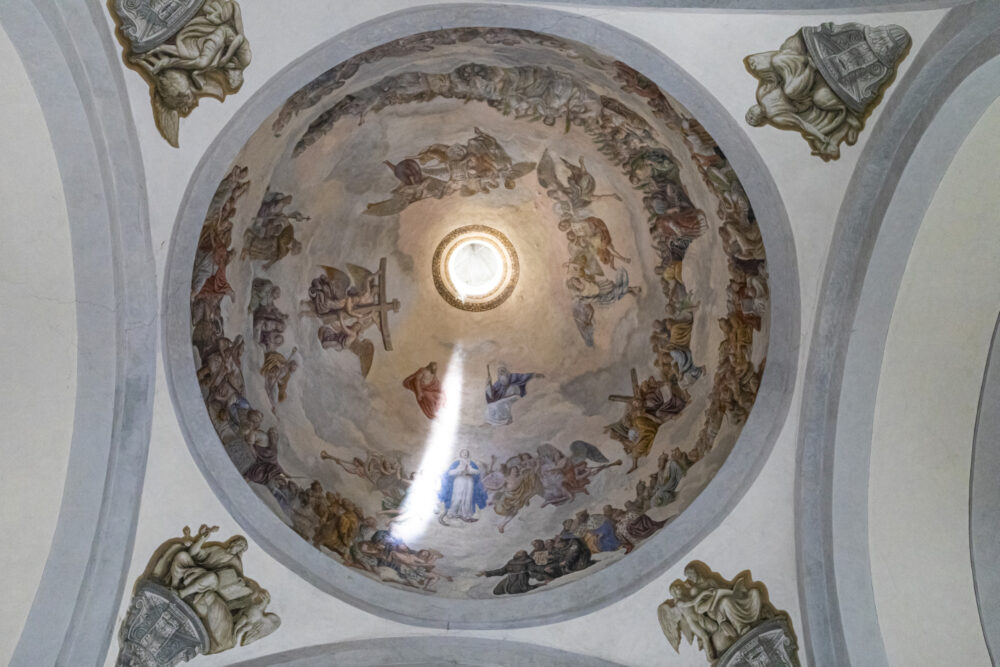Identification color on the map: red / orange / green
A land of nature, spirituality and art, Tuscan Valtiberina boasts immense expanses of woods and green areas that are now parks and nature reserves that can be explored by pilgrims and wayfarers.
On the way, there are numerous hermitages and places of faith that keep alive the memory of the passage of Francis, but also characteristic villages that preserve the legacy of top-class artists such as Piero della Francesca and Michelangelo, born in Valtiberina.
From La Verna to Anghiari: east route passing through Pieve Santo Stefano and Sansepolcro
Number of stages: 4
Total length: 64 km
Difficulty: hiking all stages
Identification color on the map: red
Once you reach the top of Monte Calvano and its spectacular 360° view, you descend towards Pieve Santo Stefano, the renowned "City of the Diary". The first stage ends at the Hermitage of Cerbaiolo, a centuries-old Benedictine monastery later given to San Francesco during one of his pilgrimages. It is also where Sant'Antonio found refuge and finished the composition of the Sermons. The hermitage was built around a seventeenth-century cloister and consists of a church, sacristy, refectory, chapel and monastic cells.
The second stage, immersed in greenery, crosses the Alpe della Luna Nature Reserve and leads to the Montagna area. In the next stage, on the road to Sansepolcro, we come across the Hermitage of Montecasale, a place of great importance for having welcomed Francesco in 1213 and remains a remarkable example of the typical architecture.
In Sansepolcro, the village in which Piero della Francesca was born, we find the Civic Museum that preserves some of the painter's great masterpieces and is also home to many churches which boast works by the artists Luca Signorelli, Perugino and Rosso Fiorentino.
The journey then continues towards Anghiari, the splendid medieval village-castle made famous by the "Battle" of the same name painted by Leonardo da Vinci. Here, among other things, we find the Church of the Cross, built right at the point where Francis planted a wooden cross into the ground during one of his return trips from La Verna to Assisi.
From La Verna to Anghiari: west route passing through Caprese Michelangelo and Montauto
Number of stages: 2
Total length: 47.40 km
Difficulty: Hiking (all stages)
Identification color on the map: red
While the east route winds along the Alpe della Luna, the west route weaves through the greenery of the Catenaia Alps that separates Valtiberina from Casentino.
About halfway through the first stage, ending in Caprese Michelangelo, the birthplace of Michelangelo Buonarroti, we see the Hermitage of the Casella. Legend says that Francesco, returning to Assisi after receiving the Stigmata, stopped in this location. Shortly thereafter the hermitage was built, with evidence dating back to 1228.
Along the second stage, shortly after passing Ponte alla Piera, the path reaches the Fabbrica della Natura, home to the Visitor and Environmental Education Center of the Monti Rognosi Nature Reserve.
Going further, you will arrive in the surroundings of Monte Acuto and Montauto Castle. Here, Francesco used to stay as a guest of the centuries-old Galbino family. It is said that the saint also stopped in Montauto in 1224, after receiving the stigmata, and on that occasion he gave his old habit to Count Alberto, now preserved at the Sanctuary of La Verna as a relic. Not far from the castle you can find the Maestà di San Francesco chapel and the Cenacolo di Montauto, a Franciscan convent that dates back to 1500.
From the Hermitage of Cerbaiolo to the Sasso di Simone passing through Badia Tedalda and Sestino
Number of stages: 3
Total length: 47.50 km
Difficulty: Hiking (all stages)
Identification color on the map: orange
The section that crosses the territories of Badia Tedalda and Sestino follows historic connection routes between the Valtiberina and the regions beyond the Apennines, linking to the eastern part of the La Verna-Anghiari stretch that passes from Pieve Santo Stefano along the top of the Passo di Viamaggio. On the way you will encounter acres and acres of shaded woodlands and fields rich in wild flora and inhabited by various types of deer and also birds of prey such as the majestic golden eagle.
Badia Tedalda, a charming mountain village surrounded by nature, can be considered the capital of the previously mentioned Alpe della Luna Nature Reserve. Don't miss the Church of San Michele Arcangelo which preserves five splendid 16th century Robbia terracottas.
In Sestino, the National Antiquarium is well worth a visit, in memory of the many legacies of the Roman era in the town and surrounding area. Also see the Church of San Pancrazio. Among the natural beauties, one cannot fail to mention the Ranco Spinoso Wildlife Park and the Sasso di Simone Nature Reserve.
Towards the Streets of Francesco in Umbria via Monterchi
Number of stages: 1
Total length: 11.60 km
Difficulty: Tourist
Identification color on the map: green
Between Sansepolcro and Anghiari on the Tuscan-Umbrian border, along Bertine and San Leo, the network of Francesco's streets in Tuscany is linked to the path that allows you to head towards Assisi to follow the Streets of Francesco in Umbria.
After a first entrance into Umbrian territory passing through Citerna, the path returns to Tuscany to cross the village of Monterchi, proudly perched in the hills of the Tiber valley. Here, the Museum of the Madonna del Parto is definitely worth a visit, which preserves a famous fresco by Piero della Francesca.

